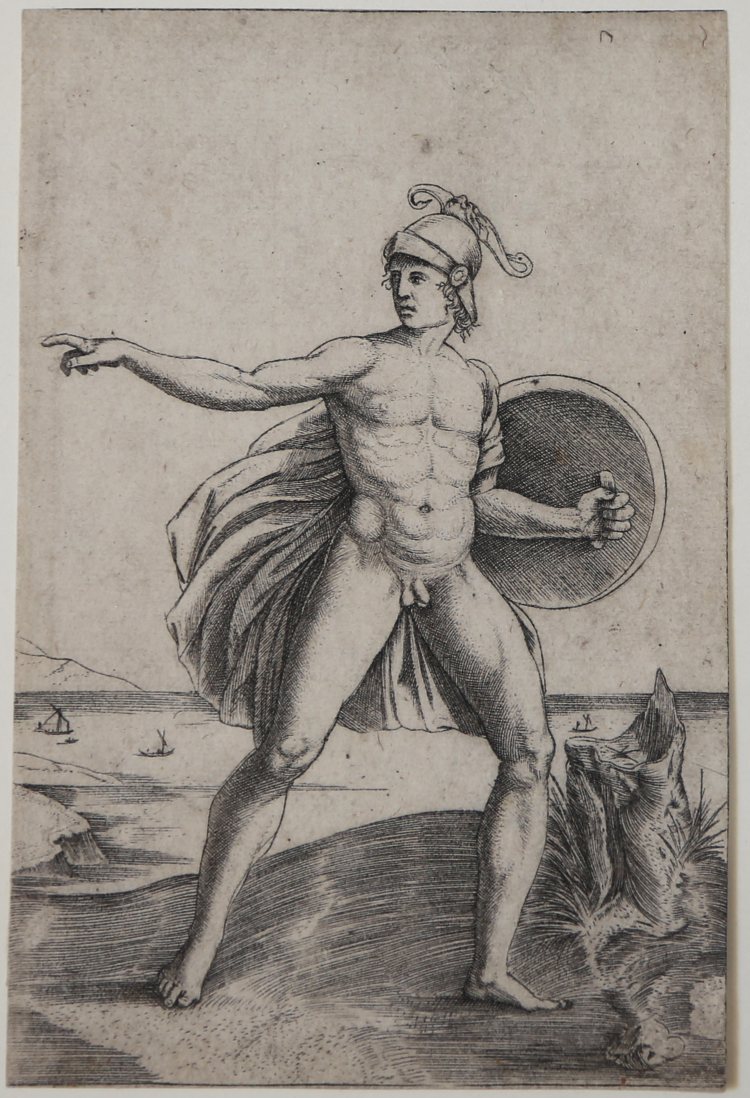




| Reference: | S38068 |
| Author | Agostino de Musi detto VENEZIANO |
| Year: | 1520 ca. |
| Measures: | 104 x 158 mm |



| Reference: | S38068 |
| Author | Agostino de Musi detto VENEZIANO |
| Year: | 1520 ca. |
| Measures: | 104 x 158 mm |
Engraving, 1515-1530, unlettered. First state, of three, ante litteram, before Salamanca’ address.
Excellent impression, printed on contemporary laid paper, trimmed at margins, in excellent condition.
The print shows a nude warrior, with one arm outstretched while the other holds a shield
Attributed by Bartsch to Agostino, possibly after a design by Raphael.
The landscape in the background reflects, in reverse, that one of the The Standard Bearer by Dürer.
Agostino de Musi, known as Agostino Veneziano, was born in the Veneto, possibly in Venice, around 1490, a period set approximately by scholars based on the earliest dates engraved on some prints. He went to Rome in 1515/16, where he entered into a relationship with Marcantonio Raimondi, becoming, along with Marco Dente, one of his principal pupil and later collaborators in the Raimondi “firm,” the first real artistic-commercial enterprise engaged in the reproduction of Raphaelesque subjects. A period, until 1520, of intense activity in Marcantonio's workshop was probably followed by more difficult years due to Raphael's death in 1520 and the imprisonment of Raimondi himself around 1523-24 for engraving some lascivious subjects.
The Sack of Rome in 1527 prompted De Musi to leave the city, heading for Mantua, attracted by Giulio Romano. The collaboration with Giulio coincided with a period characterized by high artistic achievements and intense production, dating from the years 1530-1532.
Agostino's engraving production is very large and numerically consistent, especially when compared to the short time span in which it was produced, roughly between 1514 and 1536. To the 139 engravings reported by Bartsch must be added the new 4 cited by Passavant and the 8 reported by Heinecken: these are all signed or monogrammed engravingss, sometimes consisting of normal letters, sometimes of Gothic characters; to these works must also be added a group of about 60 anonymous enrgavings of probable or doubtful attribution.
Very rare.
|
Bartsch XIV.343.461; Passavant 1864, VI, pp. 61-62, n. 106 (Musi ?); TIB, 27 p. 129, n. 461 (343)
|
Agostino de Musi detto VENEZIANO (Venezia 1490 ca. - Roma 1536/38)
|
Heir of the great tradition of the Raimondi’s, Agostino Musi, from the family de Masyus or dè Musis, also known as the Veneziano, derives his nick name from the city where he studied the “giorgionesco” style of Giulio Campagnola, di Jacopo dè Barbari and Dürer.
For a while, Agostino lived in Florence translating works from Andrea del Sarto. After that, he moved to Rome where he started working in the workshop of Bavero di Carrocci (aka Baviera) from 1516 till the Sack (Sacco) of the City.
After the Sack, he very likely went back to Florence and maybe Mantua, where he worked on Giulio Romano’s production. Between 1530 and 1531 Agostino went back to Rome and engraved the marvellous Vasi antichi e moderni, with the coats of arms of Clemente VII de Medici; in this work it can be seen his own, peculiar, ornamental style, which he used to realize splendid works for the first, great Roman publisher, Antonio Salamanca.
Bartsch ascribes to him 181 prints, dated between 1509 and 1536; Passavant then added other seven subjects (VI, pp. 49-68).
|
|
Bartsch XIV.343.461; Passavant 1864, VI, pp. 61-62, n. 106 (Musi ?); TIB, 27 p. 129, n. 461 (343)
|
Agostino de Musi detto VENEZIANO (Venezia 1490 ca. - Roma 1536/38)
|
Heir of the great tradition of the Raimondi’s, Agostino Musi, from the family de Masyus or dè Musis, also known as the Veneziano, derives his nick name from the city where he studied the “giorgionesco” style of Giulio Campagnola, di Jacopo dè Barbari and Dürer.
For a while, Agostino lived in Florence translating works from Andrea del Sarto. After that, he moved to Rome where he started working in the workshop of Bavero di Carrocci (aka Baviera) from 1516 till the Sack (Sacco) of the City.
After the Sack, he very likely went back to Florence and maybe Mantua, where he worked on Giulio Romano’s production. Between 1530 and 1531 Agostino went back to Rome and engraved the marvellous Vasi antichi e moderni, with the coats of arms of Clemente VII de Medici; in this work it can be seen his own, peculiar, ornamental style, which he used to realize splendid works for the first, great Roman publisher, Antonio Salamanca.
Bartsch ascribes to him 181 prints, dated between 1509 and 1536; Passavant then added other seven subjects (VI, pp. 49-68).
|